List of Authors
>>About this blog
Recent blog posts
|
[The Minnie Cricket]
14:00 on October 28, 2015
Oktoberfest is the world's largest festival held in Munich, the capital of Bayern, Germany, and is held from mid-September to early October, with about 6 million people visiting the venue every year (about 9 times the size of the Tokyo Dome ). About 7 million liters of beer ). About 7 million liters of beer  were consumed last year. were consumed last year.
In 1810, the wedding ceremony of the Crown Prince Ludwig and Princess Sachsen was held by many Munich citizens.
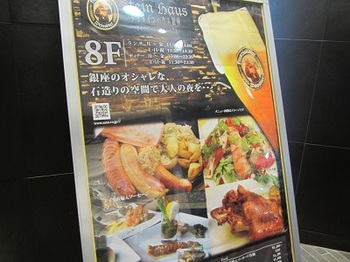
In Japan, it seems that the event was held in Hibiya City and the Red Brick Warehouse in Yokohama in 2003, and now it is being held nationwide with the name "German Beer Festival" changing venues from spring to autumn. changing venues from spring to autumn.
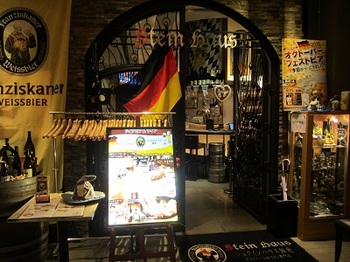
In this autumn season, there is also a German beer restaurant season, there is also a German beer restaurant in Ginza where you can enjoy the feeling of Oktoberfest. in Ginza where you can enjoy the feeling of Oktoberfest.
We will introduce "German Beer & Wine Specialty Store Stein House Ginza" (2-4-6 Ginza, Chuo-ku) on the 8th floor of the Ginza Bellavier Hall facing Namiki-dori St., Ginza, Ginza
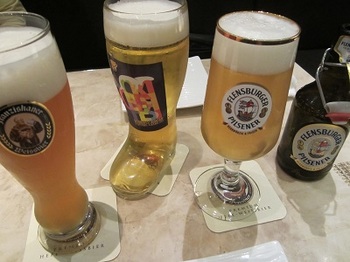
You can enjoy German beer directly imported  and premium German wine and premium German wine s. s.
German beer  has many kinds and unique flavors, and the glass has a special glass for that beer, and it is profound. has many kinds and unique flavors, and the glass has a special glass for that beer, and it is profound.
(The photo below  is ice vine) is ice vine)
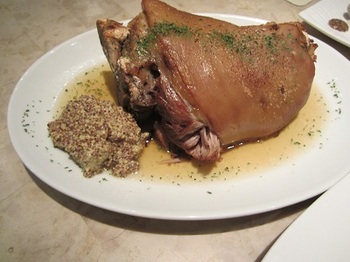
The interior is a stylish space with furniture goods imported from Europe.
There is also a bar counter where you can enjoy beer or taste ham sausages imported directly from Germany. or taste ham sausages imported directly from Germany.
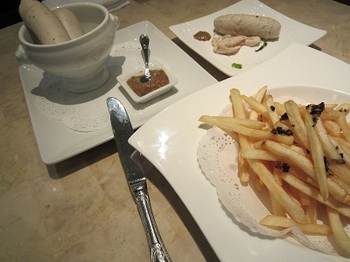
I ordered "Icevine" (savory, soft, trottoro in "The King of German Cuisine", "Boilweiss Wurst" (white sausage), "truffle in "The King of German Cuisine", "Boilweiss Wurst" (white sausage), "truffle flavor fries" (anything delicious flavor fries" (anything delicious ) etc. ) etc.
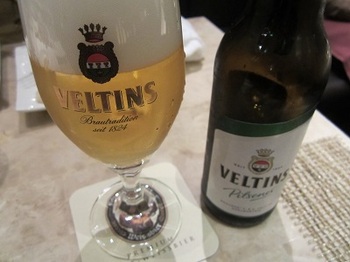
Prost  (toast (toast ) )
        
[Koedo Itabashi]
14:00 on October 28, 2015
"That's right. What's it?"
“Weird things are running. ・“The bus?”
The stop at the end of the children pointed to was a red line drawn on the yellow ground.
It was a wrapping bus with a train-like coloring.
We've never been on the Toden running through the streets of the trolley line.
The track extends near the center of the road to an area solidified with paving stones, from the overhead line.
I use a long trolley pole to drive with electricity.
Oh! I've been on Toden.
Oh, it's the Arakawa Line.
A tram that is active only in Tokyo.
In the vicinity of Prince Kita Ward, the tracks pass through the road.
The appearance of climbing Asukazaka, which is curved with a roaring engine sound,
There's something powerful.
Toden-style wrapping bus was introduced by Sam on a correspondent blog on October 24.
This is one of the events of "Tokyo Station-Nihonbashi Showa Retro Tour" that I gave you.
The future service schedule is for three days: October 31 (Sat), November 1 (Sun), and November 3 (holiday).
Operation time is from 11:00 to 19:00. The fare is free.
There are Tokyo Station course and Ningyocho course, and there are Coredo Muromachi-mae and Ningyocho amazake Yokocho entrance.
It will be a replacement for passengers.
The wrapping bus is modeled on the Toden 6000 type.
Oh! I'm not Toden Mania, but just in front of the nose, one place
If you had a replica of a large frontlight, the real feeling may have doubled.
Certainly, the 6000 type is the nickname of 'Ichikyusan.'
It came from the fact that there was one ball of the front light bulb.
Walking maps for events held until November 3 and mounts for commemorative replica hard tickets are also available.
The picture is full of retro senses and it is very cute.
A replica hard ticket that imitates an old railway ticket can be obtained at 6 locations, one by one.
There are a total of 6 types.
The date of the hard ticket is the day that is closely related to the building.
For Nihonbashi Takashimaya, "8.-3.20." in connection with the opening of the store on March 20, 1933. 。
At the Nihonbashi Mitsukoshi Main Store, the unveiling ceremony of the statue of Tenjo (Magokoro) that descended on the first floor is held.
"35.-4.19." in connection with April 19, 1960 。
This is a pretty elaborate device. It's wonderful.
The size of the hard ticket is a B-type ticket that is 2.5cm long and 5.75cm wide.
If possible, if it is an A-type Edmonson ticket with a height of 3 cm, it will be more familiar to your hands.
Oh, I'm not a ticket maniar, so I'm not very particular about it.
Only the children received replica hard tickets from the sisters at each information center.
And not from a wide range of age groups.
If you put 6 sheets on the mount, it will be a fun memorial to the Tokyo Tours.
[They are]
09:00 on October 28, 2015
There are only two months left in 2015, and November is a season when events such as cultural festival of schools, including Culture Day (holiday), but even in Chuo-ku, this weekend Sunday (November 1), the whole Chuo-ku Museum is held once a year. Posters have already been posted on the bulletin board in the city.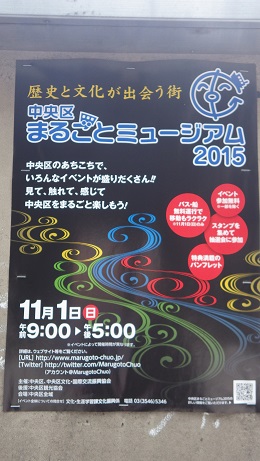
The whole museum is held for the eighth time this year, but as the name suggests, it is a day like a museum where you can enjoy the various charms of Chuo-ku, centering on official events held in various parts of the city. Not only events that convey the history and tradition of 400 years since the opening of Edo, but also contemporary and future events, art (exhibition, performance), environmental activities, barrier-free, etc. There are plenty of events unique to Tokyo, and Chuo-ku, which leads Japan (for details on the event, please refer to the information on the Marugoto Museum website at the end of the sentence).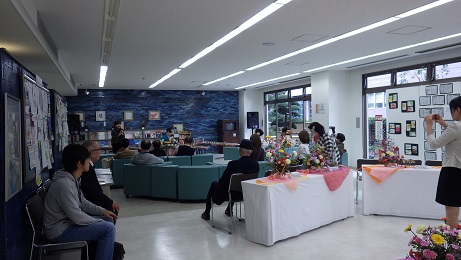
(Last year's "Chuo Kumin cultural festival" lobby concert. Tsukiji Social Education Center
The venue will be a large area of the whole area of the ward, but on the day, in addition to regular public transportation, free patrol buses (left and right), boat routes (including 4 routes and tour routes), Edo buses (Free on the day!) There is no need to worry about moving. If you participate in the stamp rally and collect more than three stamps at the event venue and fill out the questionnaire, you can also participate in the prize-winning raffle.

(The state of the tour bus stop (Tsukiji) last year. The staff in orange wear will guide you.)
Last but not least, please. The tour bus goes around routes where public transportation such as metropolitan buses do not pass much, so it is a chance to discover a new Chuo-ku from the train window. In addition, the Chuo-ku Tourism Association correspondent will guide you on the bus, so you may be able to hear special tourist information. 。 。
Please look forward to it!
[Chuo-ku Marugoto Museum]
Date and time: Sunday, November 1 9:00am to 5:00pm
Location: The whole area of the city. For more information, please refer to the website.
Marugoto Museum Website: http://marugoto-chuo.jimdo.com/
Valuable Information| Other Areas| Event Information| Ningyocho, Hamacho, Higashinihombashi area| Tsukuda, Tsukishima, Kachidoki and Harumi areas| Nihonbashi, Kyobashi, Yaesu area| History, culture| Correspondent Recommended Information| Tsukiji, Shintomi, Minato area| Kayabacho, Hatchobori, Shinkawa area| Ginza area
Page top▲
[Sumida Fireworks]
09:00 on October 28, 2015
The other day, I stopped by the "Kachidoki Bridge Museum" beside Kachidokibashi for the first time in a long time.
This museum was built by renovating the substation used to open Kachidokibashi, but it seems that this year marks the 10th anniversary.
On my way back, I received a limited postcard for the 10th anniversary from the uncle of the museum, but I was happy and asked my uncle about the questions I always thought when walking on the Sumida River Terrace .
I asked you about "Kiyosu Bridge".
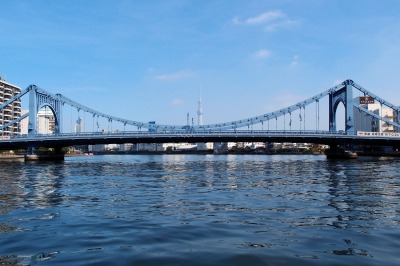 It is a suspension bridge built in a reconstruction project after the Great Kanto Earthquake and has become an important cultural property of the country. It is a suspension bridge built in a reconstruction project after the Great Kanto Earthquake and has become an important cultural property of the country.
"Eitai Bridge", which was built in the same reconstruction project, is said to be masculine, but this "Kiyosu Bridge" is said to be "feminal" because of its form, and is very popular and loved among the Sumida River bridges .
This part is where my eyes always appear when I walk on the Sumida River terrace.
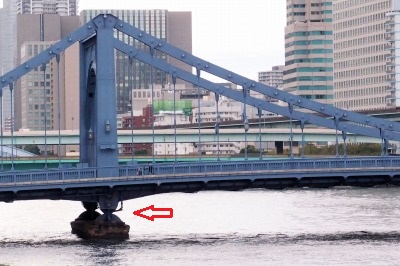
If you look at it from a distance, the lower part of the suspension bridge is constricted, and it seems to be broken somehow with a delicate feeling. The pillar of the suspension bridge had an image that it was thick and pierced into the ground, so I asked a super amateur question, "Why is this OK?"
I told you kindly, but it was a little difficult because I didn't have any prerequisite knowledge or talked about mechanics. I regretted that I should have listened after studying a little more, but I remembered the following and returned home.
・This part is a kanji character called "Kutsu" which combines "water" and "day" and is read as "shu."
・By the shoe, the direction of force due to the weight of the bridge is transmitted directly below the pier.
・The image of a bridge riding on a shoe.
A few days later, when I looked at the library, this part was called "shou", and in English it was called shoe (Shoo) and Shoo (Shoo) in shoes. In order to read "Kutsu" as "Kutsu", it seems that he uses the kanji "Kutsu" in the architectural industry term and read it as "Shu".
It is a member that conveys the weight of the bridge below, but since the bridge stretches and shrinks or distorts due to temperature changes, this bearing seems to play a role in "play" and adjusts well.
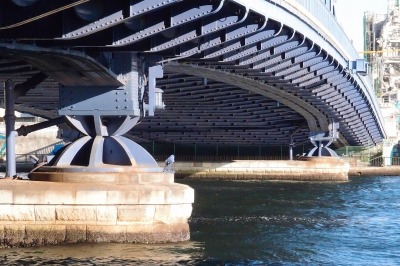 For Kiyosu Bridge, it is an image of wearing a shoe and riding a pier, so this part may be the Achilles tendon or ankle in humans. For Kiyosu Bridge, it is an image of wearing a shoe and riding a pier, so this part may be the Achilles tendon or ankle in humans.
Then, in terms of a woman's Kiyosu Bridge style, would it be like a "slim woman's ankle"? Weirdly convince me (a little excuse me?) 。
Kiyosu Bridge is a suspension bridge, but it is a suspension bridge that is rare when examined in various ways, and it is called a "automated suspension bridge".
An ordinary suspension bridge is a type called "other formal suspension bridge", and there is a weight (Ancho Reiji) for pulling the cable at both ends of the bridge.
(The photo below shows Rainbow Bridge of other fixed-type Suspension Bridge, and a huge white mass is Anka Reiji.)
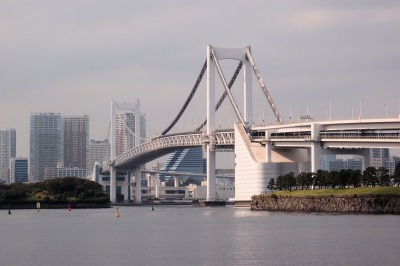
However, "autonomous suspension bridge" such as Kiyosu Bridge is a type that connects wires to both ends of the bridge girder. Since there is no weight on both ends of the bridge, it seems to be a refreshing look as a result (by the way, Kiyosu Bridge is not a wire but a steel chain, and this is also rare).
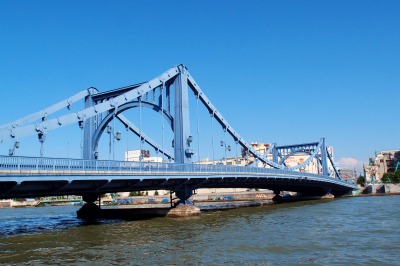
In addition, I had the image of a suspension bridge with a sturdy thick pillar piercing the ground, but in the case of a `` self-made suspension bridge '', it seems that it is related to the shape of a shoe (cloth) It seems that my way of seeing the pillars of Kiyosu Bridge was wrong.
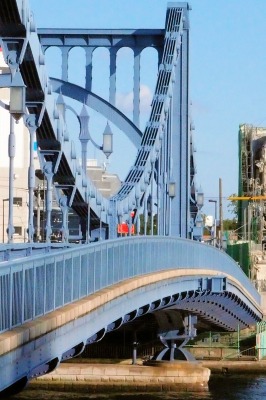 I felt that the way to make this "autonomous suspension bridge" is creating the "female charm" of Kiyosu Bridge. I felt that the way to make this "autonomous suspension bridge" is creating the "female charm" of Kiyosu Bridge.
I haven't learned enough yet, but I'm glad I was able to know a lot after asking my uncle. Thank you very much.
By the way, there are various types of bridges in the Sumida River, which is said to be the "bridge museum".
At the "Chuo-ku Marugoto Museum" on November 1st (Sun), you can get on the boat for free, but why not take a boat and compare various bridges?
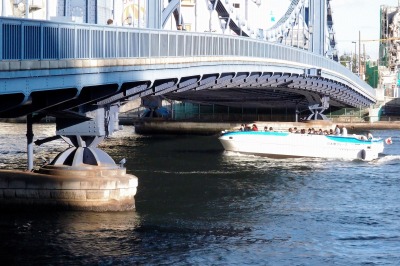
I think that there are places where Kiyosu Bridge feels feminine compared to other bridges.
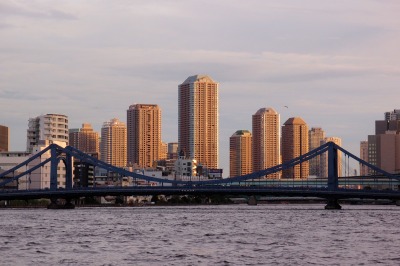 I hope you will find "female charm" by all means. I hope you will find "female charm" by all means.
[Ginzo]
18:00 on October 27, 2015
On October 24, 2015, I went to Yagenbori Mobility Shopping Street.
Welcome to the big banner and the smiling faces of everyone in the shopping district
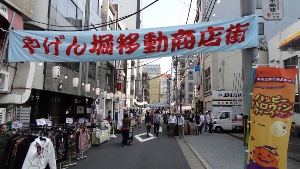
  I'm looking for a bargain. Luxury belts and shirts are very cheap. I'm looking for a bargain. Luxury belts and shirts are very cheap.
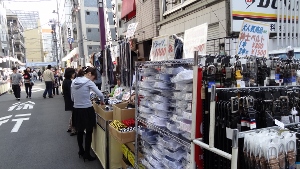
And women's hats and Italian hats are also released at a price of 2,300 yen.
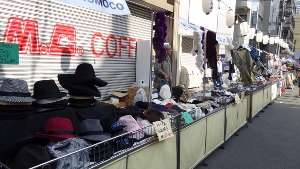
In addition, women's and gentlemen's shoes are less than half price.
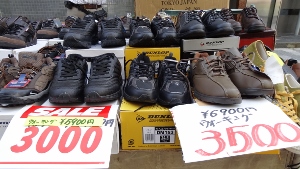
In addition, a lot of clothing, kitchen knives and nail clippers were also sold. In addition, there are workshops on "goldfish scoop ing" and "bamboo dragonfly making" which are popular among children, and it is a very fun event. ing" and "bamboo dragonfly making" which are popular among children, and it is a very fun event.
Under such circumstances, Yagenbori's mascot character, "Yagenbori Samurai", in the shape of a chili, was popular, and I purchased a ballpoint pen with a magnet in the shape of a chili. This is convenient
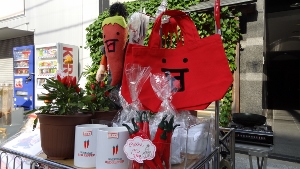
We also received a matcha reception by a local lady. It was good for you, and it was delicious. The photo shows the Kanshu of Yagenbori Fudoin, which was taken with your consent.
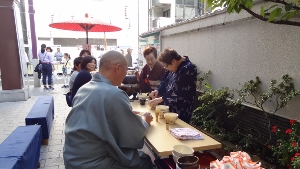
Transportation is also very convenient, close to the Toei Asakusa Line, Bakuro-Yokoyama Station on the Toei Shinjuku Line, and Bakurocho Station on the JR Line.
This time, I would like to send you gourmet information   in the vicinity. in the vicinity.
Posts: After writing so far, if you look at the whole Museum 2015 Vol.2, you will find the news of the experience of 23 Yagenbori Fudoin “Kodan”
Date and time: On November 1 (Sun), the talk session was held at 111: There are 5 times from 00 to 2 12:00 to 3 13:00 to 4 14:00 to 5 15:00 to 5. The capacity is 30 people each time, and the first 20 people will receive a gift of Shichimi karashi each time.
Location: Yagenbori Fudoin (2-6-8 Higashi-Nihonbashi), please contact us at 03-3866-6220, Mail at [email protected]
Let's get acquainted with traditional performing arts lectures and experience Edo culture.
Click here for the website of Yagenbori Shotenkai. Please refer to it next time and when you go to the annual "payment year old city".
http://www.yagenbori.net/
[Sam]
14:00 on October 27, 2015
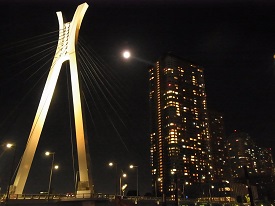 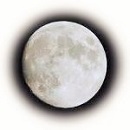 This year, October 25 is September 13 in old calendar, thirteen nights. This year, October 25 is September 13 in old calendar, thirteen nights.
It is also known as 'Kurinazuki' or 'Mamenazuki'.
The 15th night (mid-autumn moon) is called the 'previous month', the thirteenth night is called the 'later month', and the two moons together are called the 'Futayo month', and the custom of viewing moon, which has long been popular with Japanese people as a feature of autumn.
Missing one moon viewing on the 15th and 13th nights is called "Kata Mizuki", and it is said that he disliked it.
Around September 13 in old calendar is generally climatically clean and can be compared to "no cloudy on the thirteenth night."
Nationwide, the northern wind strengthened from the night of the 24th, and the 1st tree was observed in the city center, and the weather was clear on the 25th.
A beautiful moon shines beside the windows of the lit-up condominium complex in Chuo-ohashi Bridge River City.
The phase of the moon has served as a calendar for people of agricultural culture and has a history of being valued.
It is imagined that worshiping the moon and giving gratitude was more integrated into people's lives than ever before.
Thirteen nights are one step before the full moon as the age of the moon.
It is also interesting to love a slightly missing shape.
It's a bit different from fifteen nights.
|
Links
|
![]() ). About 7 million liters of beer
). About 7 million liters of beer ![]() were consumed last year.
were consumed last year.![]()
![]() changing venues from spring to autumn.
changing venues from spring to autumn.![]() season, there is also a German beer restaurant
season, there is also a German beer restaurant![]() in Ginza where you can enjoy the feeling of Oktoberfest.
in Ginza where you can enjoy the feeling of Oktoberfest.![]()
![]()
![]() and premium German wine
and premium German wine![]() s.
s.![]()
![]() has many kinds and unique flavors, and the glass has a special glass for that beer, and it is profound.
has many kinds and unique flavors, and the glass has a special glass for that beer, and it is profound.![]() is ice vine)
is ice vine)![]()
![]() or taste ham sausages imported directly from Germany.
or taste ham sausages imported directly from Germany.![]()
![]() in "The King of German Cuisine", "Boilweiss Wurst" (white sausage), "truffle
in "The King of German Cuisine", "Boilweiss Wurst" (white sausage), "truffle![]() flavor fries" (anything delicious
flavor fries" (anything delicious![]() ) etc.
) etc.![]()
![]() (toast
(toast![]() )
)![]()
![]()
![]()
![]()
![]()
![]()
![]()
![]()
![]()









 It is a suspension bridge built in a reconstruction project after the Great Kanto Earthquake and has become an important cultural property of the country.
It is a suspension bridge built in a reconstruction project after the Great Kanto Earthquake and has become an important cultural property of the country.
 For Kiyosu Bridge, it is an image of wearing a shoe and riding a pier, so this part may be the Achilles tendon or ankle in humans.
For Kiyosu Bridge, it is an image of wearing a shoe and riding a pier, so this part may be the Achilles tendon or ankle in humans.

 I felt that the way to make this "autonomous suspension bridge" is creating the "female charm" of Kiyosu Bridge.
I felt that the way to make this "autonomous suspension bridge" is creating the "female charm" of Kiyosu Bridge.
 I hope you will find "female charm" by all means.
I hope you will find "female charm" by all means.






 This year, October 25 is September 13 in old calendar, thirteen nights.
This year, October 25 is September 13 in old calendar, thirteen nights.
